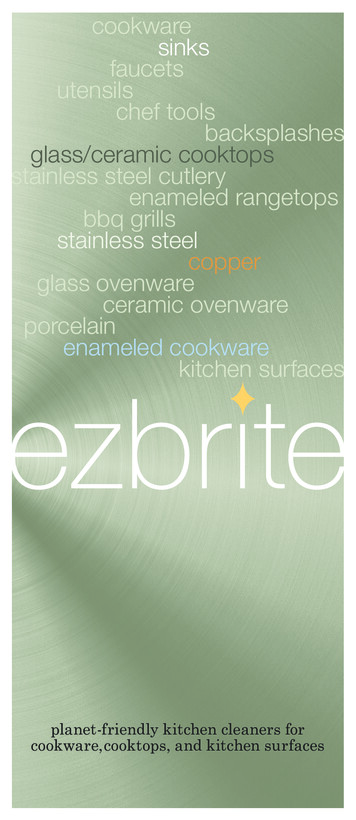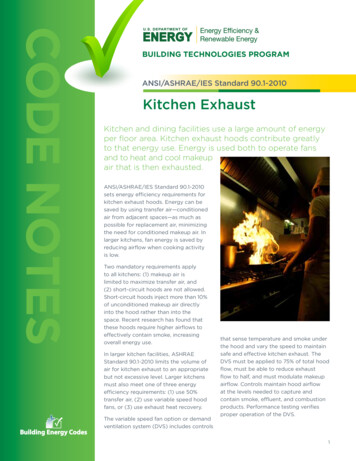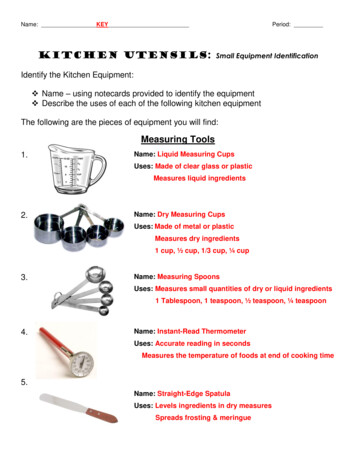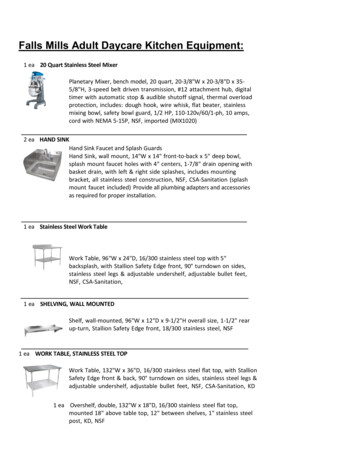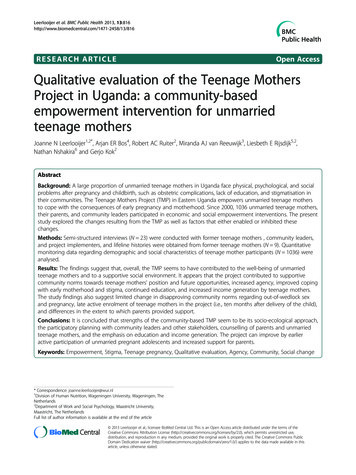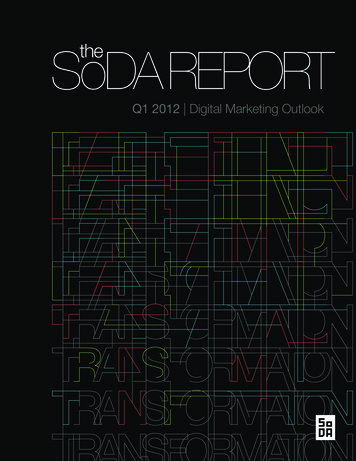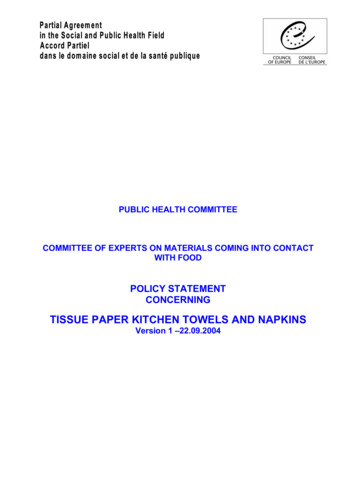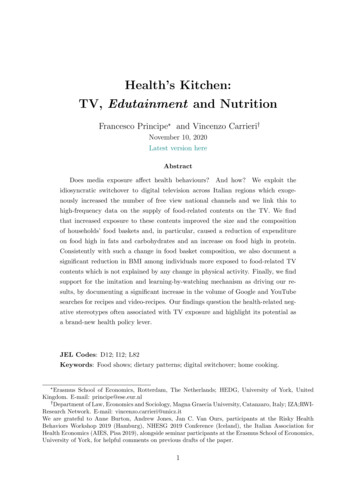
Transcription
Health’s Kitchen:TV, Edutainment and NutritionFrancesco Principe* and Vincenzo Carrieri—November 10, 2020Latest version hereAbstractDoes media exposure affect health behaviours? And how? We exploit theidiosyncratic switchover to digital television across Italian regions which exogenously increased the number of free view national channels and we link this tohigh-frequency data on the supply of food-related contents on the TV. We findthat increased exposure to these contents improved the size and the compositionof households’ food baskets and, in particular, caused a reduction of expenditureon food high in fats and carbohydrates and an increase on food high in protein.Consistently with such a change in food basket composition, we also document asignificant reduction in BMI among individuals more exposed to food-related TVcontents which is not explained by any change in physical activity. Finally, we findsupport for the imitation and learning-by-watching mechanism as driving our results, by documenting a significant increase in the volume of Google and YouTubesearches for recipes and video-recipes. Our findings question the health-related negative stereotypes often associated with TV exposure and highlight its potential asa brand-new health policy lever.JEL Codes: D12; I12; L82Keywords: Food shows; dietary patterns; digital switchover; home cooking.* ErasmusSchool of Economics, Rotterdam, The Netherlands; HEDG, University of York, UnitedKingdom. E-mail: principe@ese.eur.nl— Department of Law, Economics and Sociology, Magna Graecia University, Catanzaro, Italy; IZA;RWIResearch Network. E-mail: vincenzo.carrieri@unicz.itWe are grateful to Anne Burton, Andrew Jones, Jan C. Van Ours, participants at the Risky HealthBehaviors Workshop 2019 (Hamburg), NHESG 2019 Conference (Iceland), the Italian Association forHealth Economics (AIES, Pisa 2019), alongside seminar participants at the Erasmus School of Economics,University of York, for helpful comments on previous drafts of the paper.1
1IntroductionPeople spend a significant amount of their time watching TV. In the US, this is an averageof 2.7 hours per day. In Italy, TV is the main leisure activity: 92% of people watch TV,87% watch every day and for an average of 2.8 hours per day. A recent body of literature has documented that exposure to TV contents has a powerful impact on virtuallyall aspects of people’s lives, such as consumption, education, political behaviour, crimeperception and divorce, among others 1 . But, does media exposure also affect health behaviours? And, if so, how? Despite the great relevance of health for people’s lives, thesequestions have remained substantially unanswered so far. In a recent review of the literature on the economic and social impact of the media, DellaVigna and La Ferrara (2015)explicitly argued that “. . . surprisingly given the interest in health economics, the evidenceis limited and mostly comes from outside economics, such as health and communicationstudies”. The aim of this paper is to fill this gap.This article combines three empirical analyses based on four distinct sources of data.We explore the effect of media exposure on dietary patterns and individual health andwe investigate the role of imitation and learning-by-watching as key mechanisms linkingmedia exposure to dietary patterns and, therefore, to health. This focus on the effects ofmedia on diets is not incidental. On one hand, eating behaviours are extremely importantfor health. Non-communicable diseases, of which poor diet is a key risk factor, caused68% of the deaths globally in 2012 (World Health Organization, 2014) and poor eatingbehaviours are associated with a vast array of health issues such as obesity, diabetes andcancer, resulting in detrimental effects on individual well-being and economic outcomes(Cawley, 2015). On the other hand, the supply of media contents hasincreasingly tendedto focus on food TV shows in recent times (i.e. Hell’s Kitchen; Masterchef, etc.). Themomentum of these shows was accompanied by a sharp increase in public approval andviewing. For instance, only looking at the food show Masterchef, the average minuteaudience sharply rose from around 500,000 viewers in the first season to almost 2 millionin the following seasons (Auditel). More generally, the number of hours of programmingfor all these types of TV shows boomed from nearly 50 in 2007 to around 500 in 2013in Italy; an increase of around 900% in six years (see Figure 2 and Section 2 for moredetails).We exploit a natural experiment that occurred in Italy between 2008 and 2012, in1See DellaVigna and La Ferrara (2015) for a review.2
duced by the idiosyncratic switchover to digital television, which exogenously increasedthe number of free view national channels. One key advantage of digital technology isthat it allows broadcasting on more channels, due to the less room occupied in terms offrequencies and generating the so-called digital revenues. Thus, the digital switchoverlargely increased the possibility for new TV channels to enter the market, resulting in amassive shock of the contents’ supply. In Italy, the switchover from analogue to digital TVwas implemented region by region between October 2008 and July 2012, and the calendarof the switchover dates was set according to the state of the post-WW2 infrastructure,alternating regions from the South with regions from the North. The geographical heterogeneity in the timing of the digital switchover represents a good as random variationin the media exposure, which we exploit in a staggered Difference-in-Differences (DiD)framework.To evaluate the influence of media exposure on dietary patterns, we merge two sourcesof data. We collected data from the Italian TV programming available on the magazineTV Sorrisi e Canzoni, and selected the entire programming of all food shows scheduledon Italian TV, including the dates of the episodes and the minutes of programming foreach show. We link this unique dataset to a representative sample of around 150 thousandItalian households’ monthly-expenditure diaries, available in the Italian Household BudgetSurvey. The detail of the registered consumption is so accurate that it allows the recordingof expenditures on macronutrients, such ascarbohydrates, proteins and fats according tothe FAO’s classification. The quasi-experimental setting, combined with the availabilityof data on the minutes of exposure to the food shows and the absence of any change inthe intensive or extensive margin of TV watching (see Section 2 for more details), allowsus to rule out one of the key limitations in the analysis of the effects of the media: thepossibility of selection into television use and into a particular media (DellaVigna andLa Ferrara, 2015).As a second analysis, we assess whether induced changes in food basket compositionproduced concrete beneficial effects on health. Thus, we study the effect of TV exposureon individual Body Mass Index. To this end, we merge data on the supply of the food TVshows described above to the annual data from the Italian Multipurpose Survey, whichincludes information about a large number of socio-economic variables and individualBMI on a representative sample of the Italian population. We are thus able to testfor the effect of the region-specific digital switchover on the BMI of individuals, whileaccounting for the intensity of exposure in terms of both contents’ supply and time since3
the treatment occurred. To identify a clean effect, we take advantage of the fact thatthe survey takes place always in the same month. In addition, by exploiting data onItalian TV programming described above, we can account also for the time variation inthe supply of food shows contents and, thus, we are able to document the effect on BMIproduced by exposure to specific food show contents.This paper speaks to the growing literature analyzing the effects of media, and in particular television, on a variety of outcomes such as adult and teenage fertility (Chong andFerrara, 2009; Kearney and Levine, 2015), consumption (Bursztyn and Cantoni (2016)),education (Gentzkow and Shapiro, 2008; Kearney and Levine, 2019; Hernæs et al., 2019),voting behaviour (DellaVigna and Kaplan, 2007; Enikolopov et al., 2011; Gerber et al.,2009) and crime (Dahl and DellaVigna, 2009).With respect to the Italian case, Mastrorocco and Minale (2018) also use the transitionto digital TV to explore the effect of media coverage of crime episodes on crime perception and find that the digital switchover led to a decrease in crime concerns. Duranteet al. (2019) find that individuals with early access to Berlusconi’s all-entertainment TVchannels (Mediaset) were more likely to vote for his party in 1994. On the other hand,Barone et al. (2015) show that after a supply shock of TV contents, due to access to newdigital channels, there was a drop in Berlusconi’s vote share in the following elections.We contribute to this literature by exploring the influence of media in a domain that hasreceived very little attention so far, but that represents a key dimension of people’s lives:their health.Lastly, an additional key contribution of our analysis is to explore possible mechanismslinking media exposure to dietary patterns. In particular, we investigate on the role ofimitation and learning-by-watching mechanism which are salient features of edutainment(education and entertainment) in the context of cooking shows. Indeed, imitation andlearning-by-watching from media can arise for two reasons. On the one hand, the cultivation theory (Gerbner et al., 1980) suggests that the accumulated exposure to TV contentscan shift people’s beliefs towards representation that is consistent with the social realityportrayed on the screen. In this respect, TV leads viewers to believe that some jobs oractivities – i.e., the chef - are more attractive than they are in reality. On the otherhand, wishful identification theory (Feilitzen and Linné, 1975) explains viewers’ desires tobecome or to behave in the same way as a certain TV character seen as a role-model andthis acts as a link between media exposure and emulating behaviours. These features areinherent to cooking shows that may be best labelled as edutainment, as they have evolved4
from being predominantly about educating viewers to a mix of education and entertainment (De Backer and Hudders, 2016). The educational element is mainly characterizedby the information provision on both the nutritional values of food and the methods toprocess raw ingredients into cooked meals. The entertainment element is often offered byembedded competitions organized in the spirit of sports competitions, where participantsget eliminated at every subsequent round and, finally, a winner is elected in the concludingepisode for the season according to the votes of a jury of experts. Additionally, some elements are common to both education and entertainment, such as the preparation of mealsunder real-life situations: time constraints, limited ingredients or budget availability.Some relevant empirical literature has shown that exposure to a particular behavior ontelevision changes behavior in the audience. For instance, La Ferrara et al. (2012) estimatethe long-term imitation effects on fertility rates in Brazil of exposure to telenovelas, takingadvantage of the staggered introduction of Globo, the network that broadcasted telenovelasin Brazil. Similarly, Kearney and Levine (2015) estimate, among other outcomes, theimpact of the US show 16 and Pregnant on Google searches for keywords related tofertility choices. A number of papers has also found that imitation channel is extremelyimportant for explaining the effect of media exposure on crime (Dahl and DellaVigna,2009; DellaVigna and La Ferrara, 2015). However, there is scant evidence on the imitationchannel in the context of healthy/unhealthy behaviours. An exception is represented bysome studies on suicides. In a seminal paper, Bollen and Phillips (1982) combine U.S.daily suicide statistics and the Vanderbilt data set of television news stories on ABC,CBS, and NBC to code all stories under the heading ‘suicide’ broadcast between 1972and 1976 and find evidence of a significant increase in suicides occurring on the first twodays and on days 6-7. Baron and Reiss (1985) show that the evidence in Bollen andPhillips (1982) and in other related papers is not reliable and this is due to a lack of aclean identification strategy (DellaVigna and La Ferrara, 2015).Our paper contributes to this literature by investigating the presence of an imitationchannel concerning home cooking. Indeed, the key elements of food-TV shows are thecharismatic chef’s image and the attention to high-quality foods in terms of both ingredients and cooking methods. For instance, looking at the recipes provided by maincookery TV shows, a higher attention towards the use of healthier ingredients such as fishand white meat over more fatty ones (i.e., cured meat, butter, etc.) clearly emerge (asdocumented in Section 2 of the paper). We thus investigate whether exposure to thesemedia contents influences the propensity for home cooking by increasing the researches on5
Google and YouTube about recipes and video-recipes proposed by TV shows. To the bestof our knowledge, no previous papers have used data on video contents, which instead areproven to be very useful in order to get insights into the imitation channel as the mainmechanism through which the media influence behaviours.Our analysis leads to a number of original results. First, we find that the increasedexposure to cooking show that the contents improved the size and the composition ofhouseholds’ food baskets. In particular, we document a reduction of monthly expenditureson foods high in fats and carbohydrates, and an increase in the expenditure on thosehigh in protein. Consistently with such a change in consumption, we also documentthat the exposure caused a significant reduction in individual BMI. The effect is foundespecially among individuals watching more TV (i.e. low-educated, younger and olderindividuals) and it is not driven by any change in physical activity behaviours. Eventstudy specification shows that the significant decline in BMI starts to occur after thefirst 12 months of exposure and persists in decreasing in subsequent years. Moreover,it does not reveal any systematic pre-trends in the four years before the region-specificswitch-over. Finally, we find that the learning-by-watching channel plays a key role. Wedocument a significant increase in home cooking and in the demand for recipes on theweb. These results have relevant policy implications and highlight the potential of rolemodels on the TV to convey health-related information and promote healthier lifestyles.The remainder of the paper is structured as follows: in Section 2, we provide furtherdetails on the institutional setting. In Section 3, a description of the dataset and mainvariables is provided. Identification strategy is presented in Section 4. In Section 5, wepresent the main results. Section 6 provides some sensitivity analyses and robustnesschecks, while Section 7 summarizes and concludes the paper.2Institutional SettingThe digital switchover, i.e. the transition from analogue to digital TV broadcasting, wasdefined as part of the Action Plan eEurope 2005, approved by the Seville European Councilin June 2002, and aimed at translating connectivity to increase economic productivityand improving the quality and accessibility of services for all European countries. Onekey advantage of digital technology is that it allows the broadcasting of more channels,due to the lesser room occupied in terms of frequencies and generating the so-called6
digital revenues. Thus, the digital switchover largely increased the possibility for new TVchannels to enter the market, resulting in a massive shock of the contents’ supply.The switchover from analogue to digital TV was implemented in Italy region by region between October 2008 and July 2012, as shown in Figure 1. Italian territory wasdivided into 16 areas, mostly corresponding to one or more regions, and the calendar ofthe switchover dates was set according to the state of the post-WW2 infrastructure, byalternating regions from the North with regions from the South in order to avoid geographical disparities. At the date of the switchover, the analogue signal was switched offand households had no further access to the old analogue broadcasting on their TVs. Inorder to receive the new digital TV, a decoder at the cost of about 50 Euros was required;this was entirely subsidised by the government through vouchers.[Figure 1 here]As a result, there was a massive entrance of new channels into the market. The seventraditional free-view national channels (three from the public television Rai, three fromthe Berlusconi’s Mediaset and the independent La7) were complemented by more than50 new channels. Interestingly, these new TV channels - to attract their share of viewers- had to differentiate themselves in terms of contents, centring their offer on lifestylerelated contents, such as reality shows of various kind and in particular food TV shows,such as Masterchef and Hell’s Kitcken, among others. The massive growth in the supplyof cooking shows is documented in Figure 2, which displays an increasing intensity inthe exposure to food-related contents on the TV. Overall, from 2007 to 2013 the numberof hours of programming for these shows on the TV changed from 50 to around 500 -amassive increase of around 900%. This was almost entirely caused by the entry of thenew digital channels, which covered around the 80% of the overall supply of food-relatedcontents on TV in 2013. On the other hand, the supply of food-related shows in thetraditional channels remained fairly flat and even showed a deflection after the digitaltransition was completed in all the Italian regions.[Figure 2 here]Concerning the content of the cooking shows, some key elements emerge. First, theypropose a new image of the chef, represented as a ”cool” and charismatic person with7
both cooking and managerial skills2 . Second, the recipes proposed are generally veryhealthy, favouring the use of ingredients low in fat and wholesome cooking methods.For example, through a text analysis performed on the universe of recipes proposed incookery shows on Italian TV (summarized in Figure A2), we find that about 50% of theTV recipes include fish or white meat as the main ingredient, while just 2% include curedmeat that is considered to be less healthy. The recipe is the main focus of these showsand it is always available to the public; for example, on the show’s website, the chefsexplain to viewers how to prepare a meal by manipulating unprocessed foods (De Backerand Hudders, 2016). Last, they generated what the sociological literature has defined asfoodporn: mass-media overexposure to food. According to a recent survey, 30% of Italianspost pictures of food they cook or have at the restaurant on social media (Coldiretti/Ixe’2016). On Instagram, the most popular photo sharing social networking service, thehashtag #foodporn counts about 250 million posts to sum up with thousands of otherassociated hashtags that make food the most shared topic on the platform. All in all,cooking TV shows convey both elements of entertainment and viewers education, so thatthey can be labelled as edutainment.It is important to highlight some aspects of this transaction process that represent keyelements of our analysis. First, since the state of post WW2 infrastructure was the criterion for implementing the switchover calendar, there was no possibility for local authoritiesor TV networks’ ownerships to lobby towards an early and more favourable transition fortheir areas of interest. This feature of the Italian digital transition is highlighted in Figure 1, which shows the absence of any geographical pattern and the homogeneity betweenNorth, Centre and South in the timing of the digital switchover. Importantly, this technological change is clearly unrelated to our outcomes of interest (i.e., expenditure on food)and this allows us to treat the staggered time of the digital switchover as good as random,in our paper.2Indeed, the popularity of the chefs dramatically increased on the media. For example, as showed inFigure A1 in the Appendix, in Italy the Google searches for the chef Gordon Ramsay, after the digitaltransition was completed, reached the same levels of David Beckham, the most famous British footballerand public figure worldwide.8
3Data and variablesThe data used in this paper are drawn from four main sources. First, data about households’ expenditure come from seven waves of the Italian Household Budget Survey, from2007 to 2013. This is a cross-sectional survey carried out once a year by the Italian National Institute of Statistics (ISTAT). In agreement with EUROSTAT, the survey is basedon the harmonised international classification of expenditure voices (Classification of Individual Consumption by Purpose - COICOP) to ensure international comparability and itis included in the National Statistical Programme. This involves two important features.First, the survey is used to collect official national statistics such as the relative and absolute poverty thresholds. Since the purpose of the survey is also that of monitoring theevolution of these official statistics over time, there is large comparability across waves.Second, it includes the “obligation of response” which includes a fine for households whorefuse to respond to the survey, and this highly limits the cases of non-responses. Thesurvey involves more than 32,000 households who are randomly selected each year fromthe Italian official census and provides detailed information about the monthly expenditure of the household for goods and services destined for consumption, alongside severaldemographic and socioeconomic information. Data are collected using a dual system: apre-survey face-to-face interview, in which socio-economic information about householdsare collected, followed by a diary survey. In fact, every sampled household receives a diaryevery month where they are asked to record the daily expenditure sustained by all thehousehold’s components, the consumption of goods produced by the household and theplace of purchase of goods and services. Data are finally made available every year withexpenditures listed on a monthly basis. As stressed in the introduction, the disposal ofhigh frequency data is a key element to precisely identify our effects of interest.With respect to the outcomes, we group the items in the households’ food basket according to their macronutrients composition as provided by FAO (Food and AgricultureOrganization of the United Nations). The macronutrients - i.e. carbohydrates, proteinsand fats - generate satiety signals of varying strengths. The evidence suggests that fatshave the lowest satiating power, carbohydrates have an intermediate effect and proteinare found to be the most satiating (Stubbs et al. 1996). Thus, following the Percent DailyValue (DV) as defined by the Food and Drug Administration (FDA), our outcomes of interest consist of expenditure on foods high (i.e. the modal nutrient) in fats, carbohydratesand protein, respectively.9
Second, data about all the food TV shows broadcasted in Italy are extracted from TVSorrisi e Canzoni, the most famous Italian magazine publishing weekly TV schedules. Inparticular, we collected figures about all the TV shows included in the category ”cuisine”and then compared those with the information present on the website of the network thatbroadcasts the show in order to retrieve data about the content, the length and the numberof episodes. Hence, we built our treatment variable, which refers to the average monthlyminutes of (new) food-related TV contents. To ease the interpretation of the results, werescale our main explanatory variable, Exposure, by dividing the original exposure lengthby its standard deviation/45-minute episodes.Third, data on the indexed values of searches on Google and YouTube come fromGoogle Trends, the tool that provides information about the frequency of the researchesfor keywords or terms on the internet. Importantly, Google Trends allows selecting thegeographical area of interest, the period of time, the language and the category of reference. We collected longitudinal information, at regional level, about the monthly queriesfor some terms as “how to cook [x]”, “recipe [x]”, “recipes TV” and “video-recipe”, forthe period from 2007 through to 2013. Our sample consists of about 1600 region-monthobservations.Finally, we use data from the Multipurpose Survey carried out every year (in March)by the Italian National Institute of Statistics. This is a repeated cross-sectional survey,representative of the entire Italian population, aimed at collecting information aboutindividuals’ characteristics and their lifestyles. This allows us to retrieve anthropometricinformation in order to estimate individual BMI. Moreover, it contains several sociodemographic variables such as age, gender, family type and education, which we use ascontrol variables in our analysis.The full list of variables included in our dataset is presented in Table 1, along withmean values and standard deviations. Concerning our outcomes, we find that an Italianhousehold spends on average about 103, 115 and 150 Euros per month on food high in fats,proteins and carbohydrates, respectively, while the overall expenditure on food amountsto about 490 Euros per month, which represents about the 20% of the total monthlyexpenditure.[Table 1 here]For what concerns the other variables of interest, Italian households consist of 2.510
members on average and there is at least one university graduate in about 20% of thehouseholds in our sample. With respect to the cooking shows, in the analysed period,the Italian TV channels broadcasted about 45 new shows, consisting on average of 17.8episodes per season with a duration of 52 minutes each. This amounts to a massive supplyof about 500 hours of new food-related content in 2013 and denotes an increase of 900%compared to the pre switchover year (2007).4Empirical StategyIn order to identify the effect of media exposure on dietary choices, we exploit as a naturalexperiment the timing of the regional switchover to digital television and implement astaggered difference-in-differences study design. More formally, we estimate the followingequation:Yirt α βDSOrt δXirt γr µt γirt(1)where Y is the outcome of interest such as the expenditure in macro-nutrients and BMIof individual i, living in region r at time t. DSO is an indicator that takes value 1 if theregion r had digital switchover at time t, Xirt denotes a set of household characteristics,γrand µt are region and time (month and year) fixed effects, respectively. The coefficientrepresents the effect of media exposure on the outcome and can be given an intention-totreat interpretation as it reflects the impact of the general availability of new TV contents(including food-related ones) on dietary choices. Standard errors are clustered at regionallevel.Additionally, we exploit information about the average monthly minutes of (new)food-related TV contents to investigate the effects of the intensity of the exposure to suchcontents on households’ dietary choices. Thus, we estimate the following equation:Yirt α βDSOrt x Exposurert δXirt γr µt γirt(2)where the interaction term (DSOrt x Exposurert ) captures the direct effect of theexposure to food-related contents, given by the average monthly minutes of food showbroadcasted. All the other terms are the same as discussed in Equation (1). This specification relies on an additional source of exogenous variation (other than the staggeredregional switchover) which is the monthly variation in the supply of food related contents11
on TV.The main identifying assumption to interpret the estimates of the effect of media exposure on our outcomes as causal relies on the existence of a common trend in the outcomes,alongside different regions, in the pre-switchover periods. In our context, this equates toassuming that in the absence of the switchover and despite its timing, individuals in different regions would have reported the same trends in expenditure on foods high in fats,carbohydrates and proteins and BMI. In order to check the validity of this identificationassumption, we perform visual inspections of common trends, falsification tests based onplacebo digital switchovers, additional specifications including several trend functionalforms and region-specific trends in our model. Lastly, we perform event study analysisto rule-out systematic pre-trends affecting the results and to explore the dynamic effectof the exposure to cooking shows. Results are reported in Section 6 and provide strongsupport for our identification strategy.5ResultsThis section presents the main results of our empirical analysis. We first estimate the effectof media exposure on the dietary choice of Italian households with different exposures.Second, we evaluate the consequences of these behaviours in terms of individual health.Finally, we investigate the mechanisms driving these results exploiting longitudinal dataabout the frequency of the queries about food preparation on the internet.5.1Does media exposure affect dietary choices?Difference-in-Differences estimates of the model in Equation (1) are reported in Table 2.On average, we find that the availability of new TV contents, generated by the digitalswitchover, leads to a 2.2 Euros increase in the expenditure on food high in protein(column 2), and a reduction in expenditure on fats and carbohydrates by 0.9 and 1.3Euros, respectively (Columns 1 and 3), while no significant change in the total foodexpenditure is observed (Column 4). Interestingly, results are similar also in terms ofmagnitude when controls for average education
media on diets is not incidental. On one hand, eating behaviours are extremely important for health. Non-communicable diseases, of which poor diet is a key risk factor, caused 68% of the deaths globally in 2012 (World Health Organization, 2014) and poor eating behaviours are associat
